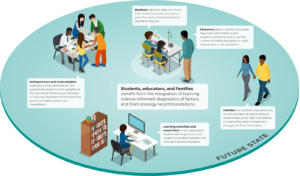Dropout prevention reports…and the rest of the solution
NASBE recently released a dropout prevention report that included some typical recommendations (data, training, community partnerships, multiple pathways). I’m glad the state boards on on the case.
NGA also issued a report which better describes the solution set including a recommendation to “provide rigorous, relevant options for earning a high school diploma.” and, “award credit for performance–not seat time–to galvanize dropout prevention and recovery efforts.”
The dropout problem in America is complicated, but I think the majority of dropouts are poorly prepared for high school, aren’t well supported at home and simply call BS on a system that doesn’t seem to know them or care about them and they leave. I like the NGA recommendations, because it suggests we can and must create better options.
I work with a group that is proving we can do better. AdvancePath runs 13 dropout prevention academies. They take kids that are several years behind and get them back on track for graduation with a rigorous competency based model that combines online and onsite learning with a flexible schedule. Every young person should have access to high quality options like AdvancePath.





john thompson
I got back on line to ask another question but it applied to dropouts just as much, so I'll bring it up here.
I've never understood why advocates of innovation don't support alternative schools, and why they aren't seen a key to turnarounds. The vast majority of inner city secondary teachers, in my experience a firm advocates of alternative schools, so there would be a natural alliance.
I was going to say that I'll be blogging on an idea that SHOULD be viable but I was just presenting as a spoof. When contracting with charters, why not give generous support but require them to take on a share of the most troubled students (who are also potential dropouts)?
Of course, "reformers" largely oppose alternative schools saying that teachers with low expectations just want to dump their toughest students. But look at this week's Ed Week! Corey Booker et al coming out in favor of alternative high schools!
If we want engaging instruction we need innovation. If we want systemic turnarounds, we need to address one of the key stumbling blocks. If we want improved teacher quality we must create conditions where teachers are able to teach. If we want to address dropouts, we need to focus on the students who are dropping out not some utopian "reform." It seems to me that expanding alternative schools are absolutely essential for all four challenges.
So, how do you respond to this proposal especially in the context of RttT?
Replies
Tom Vander Ark
There's some reformer/entrepreneur interest in alt ed. The Alternative High School Initiative (AHSI.org) is a great consortium. CIS GA developed PLCs which are attempting to scale nationally. AdvancePath and Mavericks are examples of companies trying to make a difference. Companies like Camelot and SESI do a great job in the alt & special ed space.
john thompson
What about my second point about the natural alliance between teachers and union with the organizations you cite? Why can't we work together on the issue that most inner city secondary teachers say is the most important if not the second important issue?
The better the alternative schools, the more sustainable would be the efforts to create safe and orderly schools?